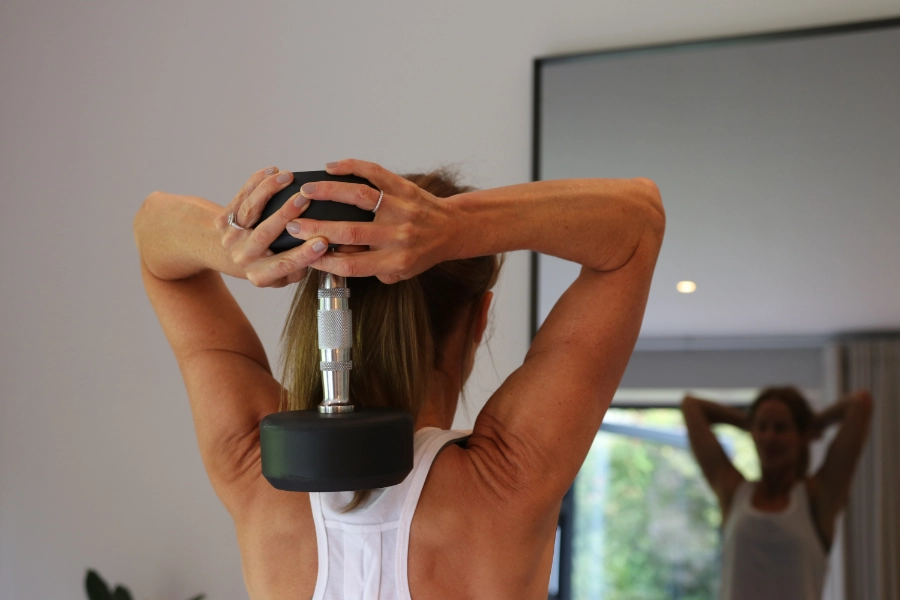There’s no doubt that you will have come across the term ‘resistance training’. But what does it actually mean? And can you do it using just your bodyweight, or do you need loads of expensive and fancy kit to get started?
Well, if you only find out one thing about resistance training make it this:
There are few types of movement that provide more benefits than resistance training.
Below, I’ll share how resistance training builds muscle, the benefits, how to get started and how to perform it safely and correctly so that you can get started on some of our best workouts.
How resistance training builds muscle
The phrase resistance training is an umbrella term for all exercise that requires the body to resist weight. This weight could be in the form of body weight, free weights, machines, resistance bands or even a couple of cans of tinned beans, if that’s what you have to hand.
Routinely lifting weights recruits new patterns of communication between the brain, nerves, neuromuscular junction, and muscle fibres. Every time you lift a weight, you engage muscles, and lay down new neuromuscular patterns, meaning that you get stronger.
Interestingly muscle strength is both a function of mass and the amount of neurological patterning of the muscle fibre. We’ve all known someone who isn’t huge in terms of mass or body size but who has lots of strength.
While there is a relationship between mass and strength, the power to move also comes from recruitment patterns in the nervous system that connect to muscle fibres. People generate more strength in their biceps if they can recruit and fire 50,000 muscle fibres than if they can only recruit 25,000 fibres.
Resistance training enables muscle recruitment which helps you to get much stronger in the first few weeks of a new strength training program without necessarily increasing your mass of muscle.
The benefits of doing resistance training
The science is certainly overwhelming in the support of resistance training, with a leading article published by Sports Medicine reporting it is ‘the most effective method available for maintaining and increasing lean-body mass and improving muscular strength and endurance’.
The key benefits from regular resistance training are:
- Lowers cholesterol
- Reduces stress and improves mood. In fact, strength training has even been proven to reduce symptoms of depression, according to a meta-analysis of 33 clinical trials.
- Increases muscle mass
- Improves body composition (the ratio of body fat to muscle you have) and burns fat. A 2017 study found that, compared with dieters who didn’t exercise and those who did only aerobic exercise, those who did strength training four times a week for 18 months lost the most fat (about 18lbs, compared with 10lbs for non-exercisers and 16lbs for aerobic exercisers).
- Improves posture
- Decreased risk of injury
- Increases bone density. In a 2017 study, just 30 minutes twice a week of high-intensity resistance and impact training was shown to improve functional performance, as well as bone density, structure, and strength in postmenopausal women with low bone mass.
- Improves sleep
- Can help you live longer. A meta-analysis found that people who perform resistance training are less likely to die prematurely than those who don’t.
- Improves cardiovascular health. A review published in 2021 showed that resistance training combined with aerobic exercise is more effective than aerobic exercise alone in heart disease rehabilitation.
How to get started
You don’t need fancy equipment to get started. The basic requirements are a mat, some light, medium and heavy dumbbells, and a kettlebell, all of which can be found in the gym. Some people start by using their body weight, then progressing to household items that they can safely lift to cause resistance for example tin cans, boxes and plastic bottles.
In terms of what to wear, again it doesn’t need to be fancy. Comfort is key, so wear clothes that do not restrict movement and allow you to sweat easily as well as a good pair of trainers.
Strength is built by creating a new stimulus on the muscles that have to adapt and become stronger to counteract the force applied. For many you can begin with using just your body weight, and once the exercises become easy it is time to up the force/stimulus through using weights.
By the last rep in any set, you should really be struggling, this ensures ‘that you fatigue the muscle fully, resulting in your body adapting and becoming stronger to be able to perform the task you ask of it.
Find a qualified instructor, who is able to give you the right amount of instruction, introduce you to a range of exercises that are challenging as well as achievable and importantly is motivating.
How to train safely and correctly
- Warm up for about five minutes before resistance training. Stretching and light aerobic exercise are good ways to warm up.
- Proper technique is essential. If you’re not sure whether you’re doing an exercise correctly, ask a qualified gym instructor for help.
- Start slowly and increase gradually. If you’re just starting out, you may find that you’re able to lift only a few kilograms. That’s okay.mOnce your muscles, tendons and ligaments get used to weight training exercises, you may be surprised at how quickly you progress. Once you can easily do 12 repetitions with a particular weight, gradually increase the weight.
- Only use safe, well-maintained equipment. Faulty equipment will significantly increase your risk of injury.
- Don’t hold your breath. Breathe normally while lifting. Exhale during the exertion or harder phase and inhale during the easier or relaxation phase.
- Always control the weights. Don’t throw them up and down or use momentum to ‘swing’ the weights through their range of motion. Once you have finished a set, gently place the weights on the floor – don’t drop them. Otherwise, you could injure yourself or people nearby.
- Maintain a strong form while lifting, as this will prevent injury through incorrect technique. Always lift weights within your own capabilities and slow down or stop if you feel the weight is out of control or too heavy.
- Use the full range of motion. It is important when lifting a weight that it travels through the full range of motion of the joint. This develops strength of the muscle at all points of the motion of the joint and decreases the chance of injury through over-stretching.
- Wear appropriate clothing that does not restrict movement and allows you to sweat easily.
- Maintain correct posture and body positioning (form) to reduce the risk of injury at all times.
- Know when not to train. Don’t try to train through an injury. Stop your workout immediately and seek medical advice. Likewise, don’t train if you are over-tired or feeling ill.
- Allow sufficient rest time. Muscle needs time to repair and grow after a workout. A good rule of thumb is to rest the muscle group for at least 24 hours before working the same muscle group again.

